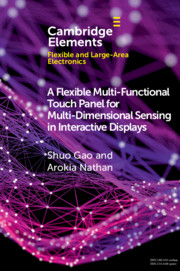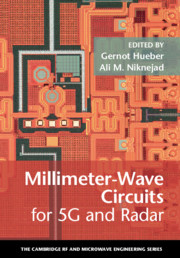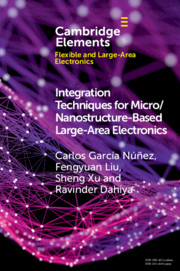Refine search
Actions for selected content:
1784 results in Circuits and systems
10 - Millimeter-Wave Frequency Synthesis Based on Frequency Multiplications
-
- Book:
- Millimeter-Wave Circuits for 5G and Radar
- Published online:
- 31 May 2019
- Print publication:
- 20 June 2019, pp 273-304
-
- Chapter
- Export citation
Index
-
- Book:
- Millimeter-Wave Circuits for 5G and Radar
- Published online:
- 31 May 2019
- Print publication:
- 20 June 2019, pp 433-436
-
- Chapter
- Export citation
7 - Millimeter-Wave Radar SoC Integration in CMOS
-
- Book:
- Millimeter-Wave Circuits for 5G and Radar
- Published online:
- 31 May 2019
- Print publication:
- 20 June 2019, pp 162-192
-
- Chapter
- Export citation
6 - Scalable RF and Millimeter-Wave Multibeam Approaches
-
- Book:
- Millimeter-Wave Circuits for 5G and Radar
- Published online:
- 31 May 2019
- Print publication:
- 20 June 2019, pp 146-161
-
- Chapter
- Export citation
3 - MU-MIMO and Massive MIMO for 5G Radios
-
- Book:
- Millimeter-Wave Circuits for 5G and Radar
- Published online:
- 31 May 2019
- Print publication:
- 20 June 2019, pp 55-83
-
- Chapter
- Export citation
Contributors
-
- Book:
- Millimeter-Wave Circuits for 5G and Radar
- Published online:
- 31 May 2019
- Print publication:
- 20 June 2019, pp xiv-xvi
-
- Chapter
- Export citation
12 - Practical VCO Design
-
- Book:
- Millimeter-Wave Circuits for 5G and Radar
- Published online:
- 31 May 2019
- Print publication:
- 20 June 2019, pp 347-368
-
- Chapter
- Export citation
4 - RF and Millimeter-Wave Full-Duplex Wireless for 5G and Beyond
-
- Book:
- Millimeter-Wave Circuits for 5G and Radar
- Published online:
- 31 May 2019
- Print publication:
- 20 June 2019, pp 84-111
-
- Chapter
- Export citation
9 - Phased Arrays for 5G Millimeter-Wave Communications
-
- Book:
- Millimeter-Wave Circuits for 5G and Radar
- Published online:
- 31 May 2019
- Print publication:
- 20 June 2019, pp 243-272
-
- Chapter
- Export citation
5 - Flexible Integrated Architectures for Frequency Division Duplex Communication
-
- Book:
- Millimeter-Wave Circuits for 5G and Radar
- Published online:
- 31 May 2019
- Print publication:
- 20 June 2019, pp 112-145
-
- Chapter
- Export citation
Index
-
- Book:
- Millimeter-Wave Circuits for 5G and Radar
- Published online:
- 31 May 2019
- Print publication:
- 20 June 2019, pp 432-432
-
- Chapter
- Export citation
11 - Digitally Intensive PLL and Clock Generation
-
- Book:
- Millimeter-Wave Circuits for 5G and Radar
- Published online:
- 31 May 2019
- Print publication:
- 20 June 2019, pp 305-346
-
- Chapter
- Export citation
Frontmatter
-
- Book:
- Millimeter-Wave Circuits for 5G and Radar
- Published online:
- 31 May 2019
- Print publication:
- 20 June 2019, pp i-iv
-
- Chapter
- Export citation
Contents
-
- Book:
- Millimeter-Wave Circuits for 5G and Radar
- Published online:
- 31 May 2019
- Print publication:
- 20 June 2019, pp vii-xiii
-
- Chapter
- Export citation

A Flexible Multi-Functional Touch Panel for Multi-Dimensional Sensing in Interactive Displays
-
- Published online:
- 14 June 2019
- Print publication:
- 30 May 2019
-
- Element
- Export citation

Millimeter-Wave Circuits for 5G and Radar
-
- Published online:
- 31 May 2019
- Print publication:
- 20 June 2019

Digital Design Using VHDL
- A Systems Approach
-
- Published online:
- 01 February 2019
- Print publication:
- 17 December 2015
-
- Textbook
- Export citation

Integration Techniques for Micro/Nanostructure-based Large-Area Electronics
-
- Published online:
- 01 November 2018
- Print publication:
- 08 November 2018
-
- Element
- Export citation
Dedication
-
- Book:
- Nonlinear Circuit Simulation and Modeling
- Published online:
- 07 June 2018
- Print publication:
- 14 June 2018, pp vii-viii
-
- Chapter
- Export citation
Index
-
- Book:
- Nonlinear Circuit Simulation and Modeling
- Published online:
- 07 June 2018
- Print publication:
- 14 June 2018, pp 340-344
-
- Chapter
- Export citation
